Grand Central Terminal: History and Hidden Gems
Grand Central Terminal, often mistakenly called Grand Central Station, is more than just a transportation hub in New York City. It’s a historical landmark and a treasure trove of hidden gems waiting to be discovered. Whether you’re a commuter, a tourist, or a history enthusiast, Grand Central offers a unique blend of architectural beauty, fascinating history, and secret spots that make it a must-visit destination.
A Brief History of Grand Central Terminal
Grand Central Terminal opened its doors in 1913, replacing the outdated Grand Central Station. Designed by the architectural firms Reed & Stem and Warren & Wetmore, the terminal was a marvel of its time, showcasing Beaux-Arts architecture. It was built to accommodate the growing number of train passengers and to serve as a gateway to the city. Over the years, it has undergone several renovations to preserve its grandeur and functionality.
The terminal played a crucial role in the development of New York City, facilitating the movement of people and goods. During its peak, it was the busiest train station in the world. However, with the rise of automobiles and air travel, its significance waned. In the 1960s, there were plans to demolish it, but thanks to a preservation campaign led by Jacqueline Kennedy Onassis, it was saved and later declared a National Historic Landmark in 1976.
Architectural Marvels and Design Features
Grand Central Terminal is renowned for its stunning architecture and design. The main concourse, with its celestial ceiling, is a sight to behold. The ceiling features a mural of the Mediterranean sky with constellations, painted in gold leaf. Interestingly, the design is reversed, a mistake that has become part of the terminal’s charm.
The terminal’s iconic clock, located at the information booth, is another highlight. Made of opal, it’s estimated to be worth millions of dollars. The clock has become a popular meeting point for visitors and locals alike.
The terminal also boasts a series of ramps instead of stairs, a revolutionary design choice at the time, allowing for smooth pedestrian flow. The whispering gallery, located near the Oyster Bar & Restaurant, is a fun architectural quirk. Stand at one corner and whisper, and your voice will be heard clearly at the opposite corner, thanks to the acoustics of the arched ceilings.
Hidden Gems and Secret Spots
Beyond its architectural beauty, Grand Central Terminal is home to several hidden gems. One such spot is the Campbell Bar, a former office turned into a cocktail lounge. Once the office of financier John W. Campbell, it retains its original 1920s decor, offering a glimpse into the past.
Another secret spot is the secret platform, Track 61, which was used by President Franklin D. Roosevelt to discreetly enter the Waldorf Astoria Hotel. While it’s not open to the public, its existence adds to the terminal’s mystique.
The Grand Central Market is a lesser-known gem, offering a variety of gourmet foods and fresh produce. It’s a great place to grab a quick bite or shop for unique culinary items. For those interested in art, the terminal hosts rotating exhibitions and installations, adding a cultural dimension to your visit.
Grand Central Terminal is more than just a place to catch a train. It’s a living piece of history, a testament to architectural innovation, and a treasure trove of hidden gems. Whether you’re exploring its history, marveling at its design, or uncovering its secrets, Grand Central offers something for everyone.
